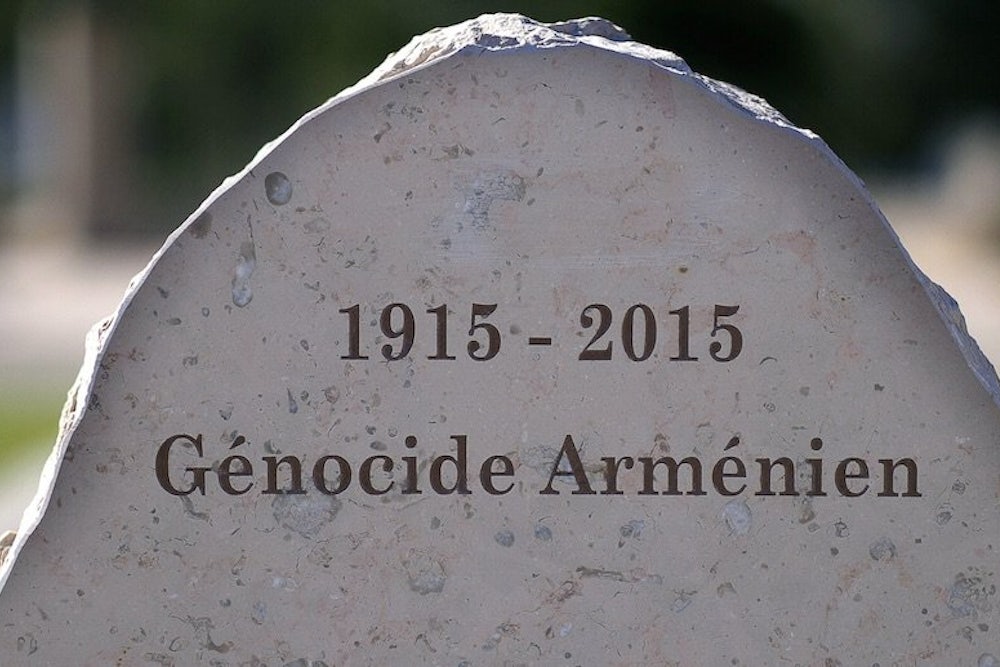Pope Francis angered the Turkish government earlier this month when he described massacres of Armenians during World War I as the “first genocide of the twentieth century.” Although there is strong consensus among historians that the word appropriately describes the destruction of Ottoman Armenians during those years, Turkey still refuses to acknowledge the genocide as such. President Barack Obama, despite his 2008 campaign promise to call the genocide by its name, is once again avoiding the word in his statement marking the event’s centennial. A century on, the term “genocide” remains remarkably politicized for both Turkey and Armenia, distracting from what is arguably one of the most important and tragic human stories of the last century.
The anniversary of the genocide is an occasion to recognize what it was, and what it was not. Though Francis meant well with his comments, placing them—as he did—in the context of ISIS’s persecution of Christians in the Middle East was misleading. Worse was a Boston Globe columnist recently characterizing the perpetrators as “jihadists.” This misunderstands the events of that period and risks perpetuating a simplistic clash-of-civilizations worldview that casts diverse groups of people into monolithic blocs and frames conflicts as fundamentally based on identity. The Young Turks’ attempt to annihilate the Christian Armenians of Anatolia was not a faith-driven genocide by radical Islamists. Nor, as many still view it, was it purely an outburst of ethnic hatred by Ottoman Turks against the Armenian minority. Though it involved these inter-communal tensions, the genocide was a process closely tied to the creation of modern nation-states.
In his newly published Great Catastrophe, Thomas de Waal aptly summarizes the most important recent scholarship on the genocide. A central theme de Waal cites is a wartime process of “cumulative radicalization” of the rulers of the Young Turk administration, also know as the Committee for Union and Progress (CUP). These were nationalist reformers who sought to modernize the “Sick Man of Europe,” as the Ottoman Empire was called during the nineteenth century. Their genocidal policies cannot be attributed to some primitive tribalism, since, as de Waal writes, the “leading Young Turk officials were among the most Europeanized and best-educated members of society.”
The Young Turk triumvirate known as the Three Pashas had de facto rule of the empire following a January 1913 coup. Two wars in the Balkans in 1912 and 1913 displaced large numbers of Ottoman Muslims: Losing territory and politically unstable, the empire was in peril. The following year, the Young Turks joined the Germans to take on the Entente forces of the U.K., France, and the Russian Empire.
World War I, and particularly the confrontation with the Russians on its eastern border, incited the Young Turks to increasingly see the Armenians as a potential fifth column. In the four decades leading up to the genocide, de Waal notes that the Armenians “had been a (mostly willing) pawn in European Great Power politics.” To deal with this perceived security threat, the Young Turks—specifically, Talat Pasha—planned to collectively punish the Armenian population through “demographic re-engineering,” remaking the ethnic landscape of eastern Anatolia. Several scholars have noted that the aim was to keep Armenians at 5 to 10 percent of the population in these regions (“a target that was sometimes over-fulfilled and reduced to almost zero,” de Waal writes). It was chillingly successful. Government forces deported and massacred more than million Armenians, while also forcing women and children to assimilate (tens of thousands of their descendants have grown up with Kurdish or Turkish identities).
While Muslim civilians killed great numbers of Armenians in the Hamidian massacres in the late nineteenth century, the role of ordinary Turks and Kurds in 1915 was “secondary to that of the state killers of the Special Organization paramilitary,” according to de Waal. Those who would paint the genocide as tribalistic violence point to the civilian Kurds and Turks who killed Armenians and pillaged their homes. But those actions, de Waal argues, were borne more of “sheer economic greed” than of tribal animosity. It makes little sense, then, to blame “Turks” or “Muslims”—terms of dubious analytic value here—if the primary actors were mainly state-hired killers acting on orders from above.
And the genocide indeed had a distinctly top-down quality. In his book on ethnic cleansing, UCLA professor Michael Mann argues that as a statist process, it was “the end product of factionalism and radicalization induced by repeated crises” created by the “unstable geopolitics” of World War I. Violent state-building was a dynamic of the time. The genocide “was not the product of ancient hatreds,” Mann writes. Rather, religious-ethnic tensions which existed were certainly “exacerbated and given direction by modern organic nationalism.”
The role of nationalism and the wars that forge nation-states are thus important elements to story of the Armenian Genocide. For all its faults, the Ottoman Empire had been surprisingly pluralistic. Its millet system allowed a degree of autonomy among its religious communities that now seems unimaginable in much of the post-colonial Middle East. This relative communal harmony broke down as the empire, following Europe’s lead, became more nationalistic. The breakdown accelerated once the CUP took power in 1908, deteriorating further with the Balkan Wars and the run-up to World War I.
Turkey will one day come to terms with its past and recognize the Armenian Genocide for what it was. More and more liberal-minded Turkish intellectuals are voicing dissent on the issue, and international pressure will continue to build. The United States, Israel, and other countries can do their part by finally using the G-word in their commemorations. But while pushing for recognition of the genocide, we can also aid reconciliation efforts by advocating a more nuanced—and more human—understanding of the atrocity.
